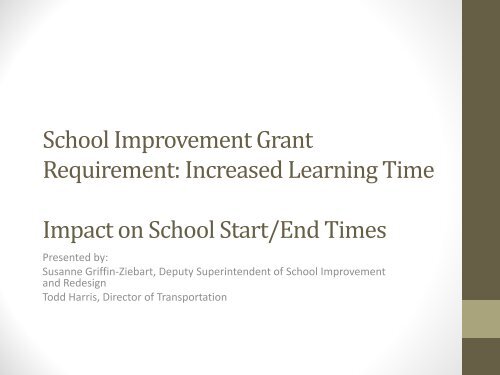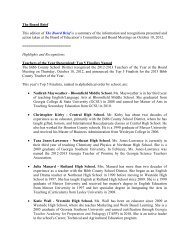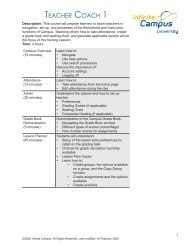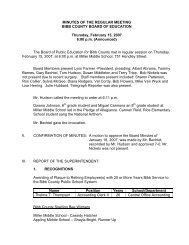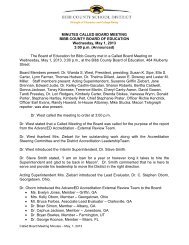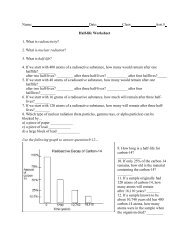School Improvement Grant Requirement ... - Bibb County Schools
School Improvement Grant Requirement ... - Bibb County Schools
School Improvement Grant Requirement ... - Bibb County Schools
Create successful ePaper yourself
Turn your PDF publications into a flip-book with our unique Google optimized e-Paper software.
<strong>School</strong> <strong>Improvement</strong> <strong>Grant</strong><br />
<strong>Requirement</strong>: Increased Learning Time<br />
Impact on <strong>School</strong> Start/End Times<br />
Presented by:<br />
Susanne Griffin‐Ziebart, Deputy Superintendent of <strong>School</strong> <strong>Improvement</strong><br />
and Redesign<br />
Todd Harris, Director of Transportation
According to United States Education<br />
Department (i.e., USED), what is the definition<br />
of “increased learning time”?<br />
“Increased learning time means increasing the length of the school<br />
day, week, or year to significantly increase the total number of school<br />
hours so as to include:<br />
• Time for instruction in core academic subjects including English,<br />
reading or language arts, mathematics, science, foreign languages,<br />
civics and government, economics, arts, history, and geography;<br />
• Time for instruction in other subjects and provision of enrichment<br />
activities that contribute to a well‐rounded education, such as<br />
physical education, service learning, and experiential and work‐<br />
based learning opportunities; and<br />
• Time for teachers to collaborate, plan, and engage in professional<br />
development within and across grades and subjects.”<br />
“Accordingly, to fully implement the turnaround or transformational<br />
model, a local education agency (LEA) must use a longer school day,<br />
week, or year to provide additional time for all three types of activities<br />
as part of the LEA’s comprehensive needs‐based plan for turning<br />
around the entire school.”
Additional Guidance from USED<br />
Increased learning time activities can include before<br />
school, after school, Saturday, and summer<br />
activities. However, this cannot be the only process<br />
used and violates the third requirement of ILT (i.e.,<br />
Provide increased learning time in the core content<br />
areas for all students).<br />
For Georgia, 300 hours of ILT is required. Of this 300<br />
hours, 60 hours are required for ILT for students<br />
during the school year. This is the equivalent of<br />
adding 20 minutes to each day for a 180 day school<br />
year. <strong>School</strong>s are encouraged to exceed the<br />
minimum.
USED Guidance for Meeting the 300<br />
Hour ILT <strong>Requirement</strong><br />
• <strong>School</strong>s must demonstrate<br />
that they have added at least<br />
60 hours to the school year.<br />
Evidence will include a<br />
submission of the daily or<br />
annual schedule. Options<br />
include:<br />
• Lengthening the school day<br />
• Lengthening the school year<br />
• <strong>School</strong>s may use a<br />
combination of before school,<br />
after school, Saturday, and<br />
summer activities to meet the<br />
remaining 240 hours of ILT.<br />
The activities must be<br />
available to all students.<br />
• Possible implementation<br />
models include:<br />
• Lengthening the school day<br />
• Each instructional block is<br />
increased<br />
• Every Tuesday/Thursday, the day<br />
is increased for a dedicated ILT<br />
focus in math/literacy<br />
• Every day, the day is increased for<br />
a dedicated ILT focus in<br />
math/literacy<br />
• Lengthening the school year<br />
• The school has a dedicated<br />
intercession for two weeks that<br />
all students MUST attend<br />
• LEAs must have evidence to<br />
support effective<br />
implementation (i.e., old/new<br />
bell schedules and/or parent<br />
letters regarding changes).
It is the expectation of the<br />
federal and state education<br />
departments that all SIG<br />
1003(g) schools are fully<br />
implementing ILT for the<br />
2012‐2013 school year.
Pertinent District Policy<br />
• Board Policy: District Organizations <strong>School</strong> Day<br />
• Descriptor Term: AF<br />
• Date: December 13, 1990<br />
• “The times for the opening and closing of the daily session(s) for<br />
employees and students shall be regulated by the superintendent.”<br />
• “The minimum work day for professional employees shall be eight<br />
hours with the employee present for seven and one‐half hours at the<br />
assigned duty location. Duties for which the base salary is paid will<br />
include administration, supervision, teaching and teacher<br />
preparation, staff meetings, conferences with students and parent<br />
planning conferences, and related school activities within the<br />
community and extra class responsibilities.”<br />
• “The school day for students in grades one through twelve shall<br />
consist of at least six (6) hours of instruction.”
Opportunity for <strong>Bibb</strong> <strong>County</strong><br />
<strong>School</strong>s<br />
• We have five SIG schools (i.e., Central, Hutchings, Northeast,<br />
Rutland and Southwest).<br />
• In order to meet the 60 hour ILT requirement during the<br />
school year, we must adjust high school bell times, minimally<br />
for SIG schools.<br />
• Adjusting bell times would require an adjustment in<br />
transportation schedules.<br />
• In order to design transportation to meet the SIG<br />
requirements, we would need to:<br />
• Provide additional routes for SIG schools only and increase<br />
transportation costs significantly; or<br />
• Adjust routes for all schools to minimize additional transportation<br />
costs.
Gathering Input: Other Districts<br />
Dr. Sharon Campbell held conversations with other SIG coordinators,<br />
principals, and state <strong>School</strong> <strong>Improvement</strong> Specialists from the districts of<br />
Peach, Henry, Spaulding, Richmond, and Burke counties at the recent SIG<br />
conference at Calloway Gardens.<br />
• Burke <strong>County</strong><br />
• Providing ILT in the morning<br />
• Providing “Power Period" of 30 additional minutes between 2 periods<br />
• Henry <strong>County</strong><br />
• Providing 10 minutes in the morning and 10 minutes in the afternoon<br />
• Adding three minutes to each class period (i.e., 7 period day)<br />
• Richmond <strong>County</strong><br />
• Adding 30 minutes to the day (i.e., 15 minutes in the morning and 15<br />
minutes in the afternoon)<br />
• Griffin (Spaulding <strong>County</strong>)<br />
• Working on designing the structure<br />
• Planning to add minutes to the school day
Gathering Input: BCSD<br />
• Donna Jackson, Heritage<br />
Elementary<br />
• Dr. Efrem Yarber, Bloomfield<br />
Middle <strong>School</strong><br />
• Emanuel Frazier, Union<br />
Elementary<br />
• Judy Vickers, Skyview Elementary<br />
• Lanny Davis, Porter Elementary<br />
• Matt Adams, Howard High <strong>School</strong><br />
• Dr. Sherri Flagg, Miller Middle<br />
<strong>School</strong><br />
• Steve Jones, Appling Middle<br />
<strong>School</strong><br />
• Todd Harris, Transportation<br />
NOTE: Other high school principals<br />
were at the SIG conference when the<br />
feedback meeting was held.<br />
Administrators<br />
• Committed to meeting federal<br />
and state requirements<br />
• Committed to creating a “win‐<br />
win” for all levels<br />
• Collaborative, honest and flexible
Bell Time Proposal<br />
Current Bell Times<br />
• High <strong>School</strong> ‐ 7:30<br />
AM to 2:30 PM (7<br />
hours)<br />
• Middle <strong>School</strong> ‐ 7:50<br />
AM to 2:40 PM (6<br />
hours, 50 minutes)<br />
• Elementary <strong>School</strong> ‐<br />
8:45 AM to 3:15 PM<br />
(6 hours, 30 minutes)<br />
Proposed Bell Times<br />
• High <strong>School</strong> ‐ 7:30<br />
AM to 3:00 PM (7<br />
hours, 30 minutes)<br />
• Middle <strong>School</strong> ‐ 7:50<br />
AM to 3:10 PM (7<br />
hours, 20 minutes)<br />
• Elementary <strong>School</strong> ‐<br />
8:45 AM to 3:45 PM<br />
(7 hours)
Because we have a two tier bussing<br />
system, it is impossible to move<br />
high school start/end times<br />
without incurring significant<br />
transportation costs OR without<br />
impacting middle school and<br />
elementary school start/end times.
Benefits<br />
• This schedule extends each school's dismissal<br />
time by 30 minutes providing additional<br />
instructional time for all students at all levels.<br />
• Maintains current start times at all levels (i.e.,<br />
no earlier start times for secondary students).<br />
• The schedule exceeds the USED requirements<br />
for SIG schools to add 60 hours to the school<br />
year.<br />
• The schedule will not have a drastic cost<br />
impact for transportation.
Remaining Opportunity: Addressing the PM<br />
Operational Delays at Some Elementary<br />
<strong>School</strong>s<br />
Some strategic procedures could be implemented to address the<br />
delays at certain elementary schools including:<br />
• Improving dismissal procedures at feeder secondary schools<br />
• Placing all secondary schools on the same schedule<br />
• Customizing bell times at certain elementary schools to<br />
increase the operational gaps (e.g., Skyview and Springdale)<br />
• Adding a few additional routes to reduce middle school<br />
double runs and give assistance in target elementary zones<br />
• Designing an alternative school bell schedule that allows the<br />
system to maximize it's resources during normal operational<br />
hours
Questions?


